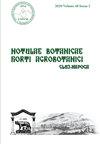多胺在洋蓟中的体内应用:对植物生长发育的影响及一些生物活性成分
IF 1.3
4区 生物学
Q3 PLANT SCIENCES
引用次数: 0
摘要
洋蓟(Cynara cardunculus var. scolymus, L.)是菊科植物的重要成员,自古以来就被用作食品,并因其具有一定的保健功效而治疗各种疾病。多胺是一种低分子量的有机化合物,在植物的一些重要的细胞和生理过程中起作用。它们参与细胞分裂、分化和生长、种子发芽、根形成以及花和果实发育等过程。它们已被确定为对生物和非生物应激因素特别有效。本研究旨在通过生物计量和生化分析,评价不同多胺类型和浓度对3个不同洋蓟品种的影响。为此,在三个洋蓟品种(Sakız OP、bayrampa本文章由计算机程序翻译,如有差异,请以英文原文为准。
In vivo polyamine applications to globe artichoke: Effects on plant growth-development and some bioactive components
The globe artichoke, Cynara cardunculus var. scolymus (L.), is an important member of the Asteraceae family, being used as a food and due to it has certain health-improving qualities in the treatment of various disorders since ancient times. Low molecular weight organic compounds with a role in several crucial cellular and physiological processes of plants are known as polyamines. They participate in processes such as cell division, differentiation, and growth, the sprouting of seeds, root formation, and flower and fruit development. They have been identified as particularly efficient against biotic and abiotic stress factors. The present research aimed that the evaluation of effects of various polyamine (PA) types and concentrations on three different artichoke cultivars by biometric measurements and biochemical analyses. For this purpose, seedlings of three artichoke cultivars (‘Sakız OP’, ‘Bayrampaşa OP’, and ‘Olympus F1’) were sprayed with various concentrations (0, 50, 100 and 250 mg L-1) of three distinct types of significant polyamines, including putrescine, spermidine, and spermine. Several growth parameters were examined in the current research. The effects on the total phenol and antioxidant capacities, as well as changes in the amounts of cynarin and 1,5-O-dicafeoylquinic acid, were also evaluated. The results revealed that there were statistically differences based on cultivars and treatment concentrations. Among the three forms of PA spermine was potent at increasing total phenolic content, while putrescine was effective at increasing total antioxidant content. On the other hand, putrescine, spermine and, spermidine had no positive effects on cynarin and 1,5-O-dicaffeoyquinic acid levels. Results clearly revealed that each biometric data and biochemical content could not be determined by a single polyamine type and concentration. It can be concluded that to improve the biometric values and biochemical content are depending on cultivar and dosage of various PAs.
求助全文
通过发布文献求助,成功后即可免费获取论文全文。
去求助
来源期刊

Notulae Botanicae Horti Agrobotanici Cluj-napoca
PLANT SCIENCES-
CiteScore
2.70
自引率
0.00%
发文量
118
审稿时长
3 months
期刊介绍:
Notulae Botanicae Horti Agrobotanici Cluj-Napoca is a peer-reviewed biannual journal aimed at disseminating significant research and original papers, critical reviews and short reviews. The subjects refer on plant biodiversity, genetics and plant breeding, development of new methodologies that can be of interest to a wide audience of plant scientists in all areas of plant biology, agriculture, horticulture and forestry. The journal encourages authors to frame their research questions and discuss their results in terms of the major questions of plant sciences, thereby maximizing the impact and value of their research, and thus in favor of spreading their studies outcome. The papers must be of potential interest to a significant number of scientists and, if specific to a local situation, must be relevant to a wide body of knowledge in life sciences. Articles should make a significant contribution to the advancement of knowledge or toward a better understanding of existing biological and agricultural concepts. An international Editorial Board advises the journal. The total content of the journal may be used for educational, non-profit purposes without regard to copyright. The distribution of the material is encouraged with the condition that the authors and the source (Notulae Botanicae Horti Agrobotanici Cluj-Napoca or JCR abbrev. title Not Bot Horti Agrobo) are mentioned.
 求助内容:
求助内容: 应助结果提醒方式:
应助结果提醒方式:


